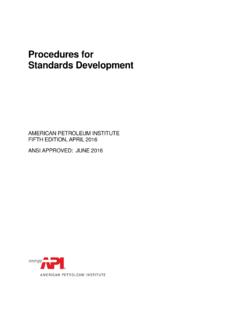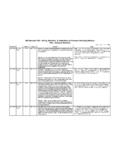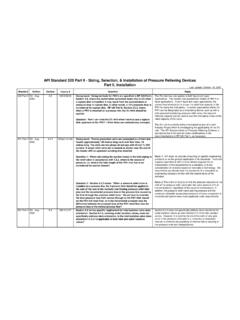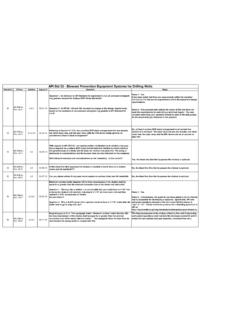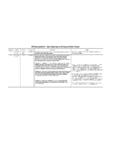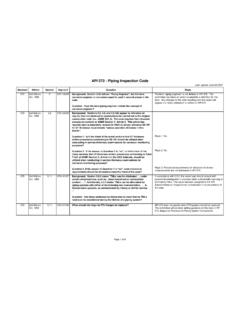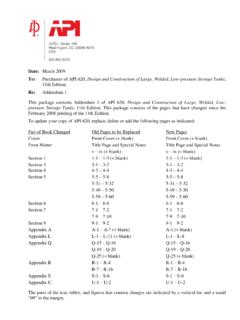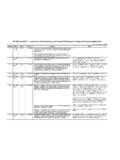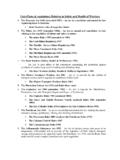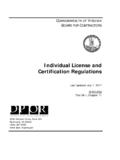Transcription of Recommended Practice for Classification of Locations for ...
1 DRAFT FOR COMMITTEE USE ONLYR ecommended Practice for Classification of Locations for Electrical Installations at petroleum Facilities Classified as Class I, Division 1 and Division 2 API Recommended Practice 500 THIRD EDITION, XXXXX 20082nd Ballot Draft, 12/9/08 DRAFT FOR COMMITTEE USE ONLY2nd Ballot Draft, 12/9/08 DRAFT FOR COMMITTEE USE ONLYR ecommended Practice for Classification of Locations for Electrical Installations at petroleum Facilities Classified as Class I, Division 1 and Division 2 Upstream SegmentAPI Recommended Practice 500 THIRD EDITION, XXXX 20082nd Ballot Draft, 12/9/08 DRAFT FOR COMMITTEE USE ONLYS pecial NotesAPI publications necessarily address problems of a general nature. With respect to particular circumstances, local, state, and federal laws and regulations should be API nor any of API's employees, subcontractors, consultants, committees, or other assignees make any warranty or representation, either express or implied, with respect to the accuracy, completeness, or usefulness of the information contained herein, or assume any liability or responsibility for any use, or the results of such use, of any information or process disclosed in this publication.
2 Neither API nor any of API's employees, subcontractors, consultants, or other assignees represent that use of this publication would not infringe upon privately owned publications may be used by anyone desiring to do so. Every effort has been made by the Institute to assure the accuracy and reliability of the data contained in them; however, the Institute makes no representation, warranty, or guarantee in connection with this publication and hereby expressly disclaims any liability or responsibility for loss or damage resulting from its use or for the violation of any authorities having jurisdiction with which this publication may publications are published to facilitate the broad availability of proven, sound engineering and operating practices . These publications are not intended to obviate the need for applying sound engineering judgment regarding when and where these publications should be utilized.
3 The formulation and publication of API publications is not intended in any way to inhibit anyone from using any other manufacturer marking equipment or materials in conformance with the marking requirements of an API standard is solely responsible for complying with all the applicable requirements of that standard. API does not represent, warrant, or guarantee that such products do in fact conform to the applicable API rights reserved. No part of this work may be reproduced, stored in a retrieval system, or transmitted by any means, electronic, mechanical, photocopying, recording, or otherwise, without prior written permission from the publisher. Contact the Publisher, API Publishing Services, 1220 L Street, , Washington, 2008 American petroleum Institute2nd Ballot Draft, 12/9/08 DRAFT FOR COMMITTEE USE ONLYF orewordNothing contained in any API publication is to be construed as granting any right, by implication or otherwise, for the manufacture, sale, or use of any method, apparatus, or product covered by letters patent.
4 Neither should anything contained in the publication be construed as insuring anyone against liability for infringement of letters document was produced under API standardization procedures that ensure appropriate notification and participation in the developmental process and is designated as an API standard. Questions concerning the interpretation of the content of this publication or comments and questions concerning the procedures under which this publication was developed should be directed in writing to the Director of Standards, American petroleum Institute, 1220 L Street, , Washington, 20005. Requests for permission to reproduce or translate all or any part of the material published herein should also be addressed to the , API standards are reviewed and revised, reaffirmed, or withdrawn at least every five years.
5 A one-time extension of up to two years may be added to this review cycle. Status of the publication can be ascertained from the API Standards Department, telephone (202) 682-8000. A catalog of API publications and materials is published annually by API, 1220 L Street, , Washington, revisions are invited and should be submitted to the Standards Department, API, 1220 L Street, NW, Washington, 20005, Ballot Draft, 12/9/08 DRAFT FOR COMMITTEE USE ONLY2nd Ballot Draft, 12/9/08 DRAFT FOR COMMITTEE USE ONLYT able of Contents will be generated with Final Page Ballot Draft, 12/9/08 DRAFT FOR COMMITTEE USE ONLYI ntroductionThis Recommended Practice is under the joint jurisdiction of the API Exploration and Production (E&P) Department, Committee on Production Equipment Standards, the API Manufacturing Distribution and Marketing (MDM)
6 Department, Committee on Refinery Equipment, and the Pipeline Operations Technical Committee. It is based upon a level of knowledge gained through experience and through the successful application of this Practice in the refining, drilling and producing, and pipeline segments of the petroleum industry. The first edition of this Recommended Practice was issued June 1, 1991 under the joint jurisdiction of the API Production, Refining and Transportation first edition of RP 500A was published in February 1955 as API 500, Recommended Practice for Classification of Areas for Electrical Installations in petroleum Refineries. The second edition was published in January 1957. The third edition was published as API 500A in April 1966. The third edition was reaffirmed in 1973.
7 The fourth edition was published in January 1982 as API 500A, with a new title, Classification of Locations for Electrical Installations in petroleum Refineries. The fourth edition was reaffirmed in December 1987. API 500B was originally issued January 1961 as API llJ, Recommended Practice for Placement of Electrical Equipment on Production Leases. The first edition of API 500B was issued in January 1966 under the title Recommended Practice for Classification in Areas for Electrical Installations at Production Facilities. The title was changed in the second edition, July 1973, to Recommended Practice for Classification of Areas for Electrical Installations at Drilling Rigs and Production Facilities on Land and on Marine Fixed and Mobile Platforms.
8 The third edition of API 500B, Recommended Practice for Classification of Locations for Electrical Installations at Drilling Rigs and Production Facilities on Land and on Marine Fixed and Mobile Platforms was issued October 1, 1987. The first edition of API 5 OOC was published in September 1966, under the title Recommended Practice for Classification of Areas for Electrical Installations at petroleum and Gas Pipeline Transportation Facilities, The first edition was re-approved in 1974. The title was changed in the second edition, July 1984, to Classification of Locations for Electrical Installations at Pipeline Transportation Facilities. The second edition was reaffirmed in March Ballot Draft, 12/9/08 DRAFT FOR COMMITTEE USE ONLY1 Recommended Practice for Classification of Locations for Electrical Installations at petroleum Facilities Classified as Class I, Division 1 and Division 21 Purpose The purpose of this Recommended Practice (RP) is to provide guidelines for classifying Locations Class I, Division 1 and Class I, Division 2 at petroleum facilities for the selection and installation of electrical equipment.
9 Basic definitions given in the 2008 Edition of NFPA 70, National Electrical Code (NEC), have been followed in developing this RP. This publication is only a guide and requires the application of sound engineering Recommendations for determining the degree and extent of Locations classified Class I, Zone 0, Zone 1, and Zone 2 are addressed in API 505, Recommended Practice for Classification of Locations for Electrical Installations at petroleum Facilities Classified as Class I, Zone 0, Zone 1, and Zone Electrical installations in areas where flammable liquids, flammable gases or vapors, or combustible liquids are produced, processed, stored or otherwise handled can be suitably designed if the Locations of potential sources of release and accumulation are clearly defined.
10 Once a location has been classified, requirements for electrical equipment and associated wiring should be determined from applicable publications. Applicable publications may include NFPA 70 or API 14F. Reference Section 2 for publications for other possible This document applies to the Classification of Locations for both temporarily and permanently installed electrical equipment. It is intended to be applied where there may be a risk of ignition due to the presence of flammable gases, flammable liquid-produced vapors, or combustible liquid-produced vapors, mixed with air, under normal atmospheric conditions (identified throughout this document as flammable gases and vapors ). Normal atmospheric conditions are defined as conditions that vary above and below reference levels of kPa ( psia) and 20 C (68 F) provided that the variations have a negligible effect on the explosion properties of the flammable following items are beyond the scope of this )Piping systems used for odorized natural gas used as fuel for cooking, heating, air conditioning, laundry and similar ) Catastrophes such as well blowouts or process vessel ruptures.
